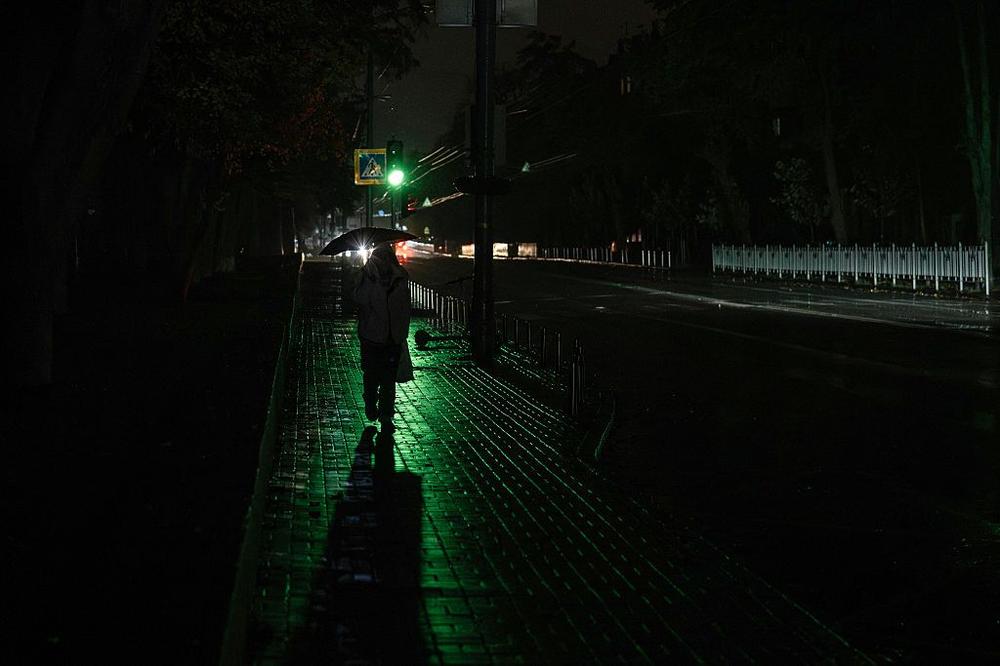Key developments on Oct. 11-12:
- Russia launched over 3,100 drones, 92 missiles, nearly 1,360 aerial bombs against Ukraine in a week, Zelensky says
- Ukraine liberates village in Zaporizhzhia Oblast, military claims
- Russia cuts Zaporizhzhia nuclear plant from Ukrainian grid to test Russian link as blackout nears 3 weeks, Kyiv says
- Over 135,000 Russian soldiers killed in Ukraine identified by media investigation
- Russia has pounded Ukraine's rail infrastructure 300 times since August, official says
Russian troops launched more than 3,100 drones, around 1,360 glide bombs and 92 missiles of various types on Ukraine in the past week, President Volodymyr Zelensky said on Oct. 12.
In a renewed effort to disrupt Ukraine's energy grid ahead of winter, Russia carried out several large-scale missile and drone strikes on energy and gas facilities this week.
An overnight attack on Oct. 10 led to widespread power outages across multiple regions. Civilian infrastructure was also hit, resulting in casualties in Kyiv, Zaporizhzhia and Dnipropetrovsk oblasts.
Zelensky said Russia is ramping up attacks as global attention shifts to the Middle East, where Israel and Hamas this week agreed to the first phase of a U.S.-brokered peace plan.
"That is precisely why no weakening of pressure can be allowed," the president said. "Sanctions, tariffs, and joint actions against the buyers of Russian oil — those who finance this war — must all remain on the table."
Earlier this week, Zelensky warned that Russian citizens will experience blackouts if Moscow attempts to inflict them on Ukraine.
A Ukrainian attack already damaged energy facilities in the Russian city of Belgorod on Oct. 5, leaving nearly 40,000 residents without electricity.
Ukraine has also intensified its attacks on Russian oil refineries, striking at least 16 of Russia’s 38 facilities since August 2025, according to the Financial Times. The strikes have pushed diesel exports to their lowest levels since 2020.
Ukraine liberates village in Zaporizhzhia Oblast, military claims
Ukrainian troops have liberated the village of Mali Shcherbaky in Zaporizhzhia Oblast, Ukraine's 24th Separate Assault Battalion "Aidar" announced on Oct. 12.
According to the statement, units of the Aidar Battalion, together with the 33rd Separate Assault Regiment raised the Ukrainian flag over Mali Shcherbaky.
"The settlement is under the control of the Ukrainian Defense Forces," the battalion said, releasing footage purportedly showing Ukrainian soldiers in the village.
The Kyiv Independent could not verify the claim.
Mali Shcherbaky lies in the Orikhiv sector in Ukraine's southeastern Zaporizhzhia Oblast. Russian troops advanced toward the settlement in early summer. Since then, it had remained either in a contested grey zone or under Russian control, according to the open-source battlefield monitoring group DeepState.
It remains unclear when exactly the village was liberated. The General Staff of Ukraine's Armed Forces rarely confirms the loss of territory to Russian forces.
In early September, Commander-in-Chief Oleksandr Syrskyi said that Russian forces had planned to launch a major offensive in the Zaporizhzhia direction but Ukrainian troops prevented the operation.
Moscow currently occupies about 70% of Zaporizhzhia Oblast, but the regional capital, Zaporizhzhia, remains under Ukrainian control.
Over the past month, Ukrainian forces have been pushing back Russian troops who had advanced 15-20 kilometers (6 miles) toward the strategic Dobropillia–Kramatorsk highway, near the contested city of Pokrovsk.
In the meantime, Russian forces continue pushing into the neighboring Dnipropetrovsk Oblast though Syrskyi called the presence of Russian troops there merely "declarative."
Russia cuts Zaporizhzhia nuclear plant from Ukrainian grid to test Russian link as blackout nears 3 weeks, Kyiv says
In an unprecedented move, Russia deliberately broke the connection between the occupied Zaporizhzhia Nuclear Power Plant (ZNPP) and the Ukrainian power grid to test its integration into the Russian network, Foreign Minister Andrii Sybiha said on Oct. 12.
The Zaporizhzhia plant, the largest nuclear plant in Europe, has been in blackout mode for nearly three weeks since the end of September, posing a threat to nuclear safety.
Russian troops reportedly struck a power line on Sept. 23, severing the plant's connection to Ukraine's electrical grid. As a result, the plant has been forced to rely on backup diesel generators to maintain critical safety functions and provide electricity.
"Not only is this an attempted theft of a peaceful Ukrainian nuclear facility. Unauthorized actions of Russia's (state nuclear energy corporation) Rosatom violate internationally recognized nuclear safety protocols, contradict Ukrainian license, and directly threaten a nuclear incident," Sybiha said on X.
The minister said that Russia must halt its attacks on the plant and allow repairs to the power lines to end the blackout. He also called on the international community to recognize Moscow's actions as illegal and "critically dangerous," and urged the International Atomic Energy Agency (IAEA) to put pressure on Russia.
As concerns about a potential crisis at the plant mounted, the IAEA said on Oct. 6 that its team heard "several rounds of incoming and outgoing shelling from near the site."
After Russian state media put the blame for the attacks on Ukraine's Armed Forces, the Ukrainian Foreign Ministry said on Oct. 6 that it was "a deliberate provocation by Russia."
The Zaporizhzhia plant has been under Russian occupation since March 2022. Its six reactors were shut down a month after Moscow’s occupation, but the facility still requires electricity to maintain cooling and prevent a nuclear incident.
Ukraine continues to demand the withdrawal of Russian forces from the plant and the establishment of a demilitarized zone around the facility, a proposal Russia has repeatedly rejected.
Over 135,000 Russian soldiers killed in Ukraine identified by media investigation
Russian independent media outlet Mediazona, in collaboration with the BBC Russian service, has confirmed the identities of 135,100 Russian military personnel killed in Ukraine.
The publications' latest report covers the period of Feb. 24, 2022 to Oct. 9, 2025. Since it was last updated at the end of September, 2,485 additional Russian military personnel have been confirmed killed.
The journalists note that the actual figures are likely significantly higher, as their verified information comes from public sources such as obituaries, posts by relatives, memorial community tree-plantings, regional media reports, statements from local authorities, among other sources.
The reported death toll now includes 38,200 volunteers, 18,450 recruited prisoners, and 15,200 mobilized soldiers, according to the media outlets. Over 5,800 officers have also been confirmed to have been killed.
In August, Mediazona, in collaboration with independent Russian outlet Meduza, released a report estimating that an estimated 220,000 Russians have been killed in the country's war against Ukraine — although that number has grown since.
The average age of the dead soldiers was 35.
The Kyiv Independent could not independently verify the figures reported by the publications.
Moscow and Kyiv rarely officially report their losses. Ukraine estimates that Russia's overall casualties during the full-scale war have surpassed 1 million.
In a briefing to reporters on Aug. 12, President Volodymyr Zelensky claimed that Russian losses are approximately three times greater than that of Ukraine, without specifying the total number of losses suffered.
Despite the heavy losses, Russia has been able to make advances in Donetsk Oblast in Ukraine's east as it is able to offset its casualties through fresh contract soldiers. In turn, Kyiv faces increasingly serious manpower shortages, particularly among infantry units holding the front line.
As of Oct. 11, Ukraine's General Staff estimates that Russia has lost 1,121,570 troops in Ukraine since the start of the war on Feb. 24, 2022. The numbers are largely in-line with estimates made by Western intelligence agencies.
The outlet published the complete list of identified casualties for the first time in February, marking three years since Russia launched its full-scale invasion of Ukraine. According to the publication, volunteers manually enter and verify each record to prevent duplicate entries in the database.
Russia has pounded Ukraine's rail infrastructure 300 times since August, official says
Russian forces have carried out nearly 300 attacks on Ukrainian Railways (Ukrzaliznytsia) infrastructure since the beginning of August, Deputy Prime Minister for Reconstruction Oleksii Kuleba said on Oct. 12.
Russia has intensified attacks on Ukraine's railway infrastructure as autumn sets in, resulting in increasing train delays and cancellations.
"Every day, the railway manages to restore infrastructure within an average of four hours after an attack — and resumes operations the very same day," Kuleba said.
Since the start of the full-scale invasion, 221 railway workers have been injured and 37 others killed in the line of duty, the officials said.
There have also been several instances where Russia targeted passenger trains, resulting in civilian casualties. A Russian double-tap drone strike on a railway station in Sumy Oblast on Oct. 4 killed one person and injured at least 30 others, including three children.
Dmytro Zhmailo, a military expert and executive director of the Ukrainian Security and Cooperation Center, suggested the uptick in attacks on Ukraine's railway system could be linked to recent arms supply agreements with Western partners.
The surge in Russian attacks coincides with the approval of the first arms deliveries under the Prioritized Ukraine Requirements List (PURL), a mechanism that enables other NATO members to finance U.S. shipments of weapons to Ukraine.

 “It completely shifted my perspective on human connection”: 20 video games that changed players’ lives forever
“It completely shifted my perspective on human connection”: 20 video games that changed players’ lives forever